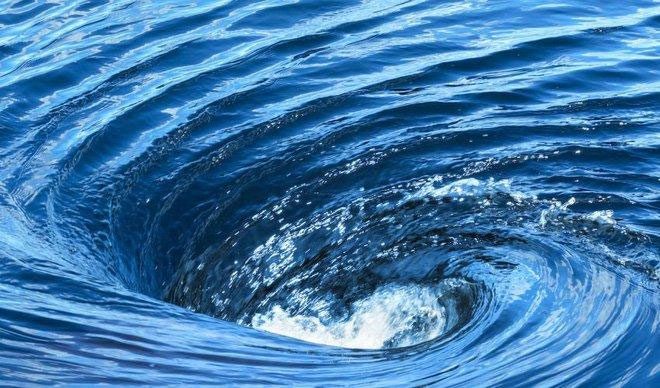The river water is flowing fiercely, and when it reaches the bridge pier, it is obstructed, forcing it to retreat. However, behind it is the rushing water that pulls it along. Thus, this body of water cannot move forward or backward, and ends up swirling in circles near the bridge pier. This is where a whirlpool forms.
What is a whirlpool?

Whirlpools can easily form in areas where the river bends or has sharp turns.
In the river, whirlpools can also form around wooden piles or rocky outcrops that rise above the water surface. This occurs because when the water encounters obstacles, it can only flow around them. When it reaches the backside of the obstacle, the water flows slowly in that area, affecting the flow of the river, causing it to crash into the water that obstructs its current, creating a circular motion.
Whirlpools are likely to form in areas where the river bends or has sharp angles. Since river water tends to flow in a straight line, the water near the inner edge of the bend “breaks away” from the riverbank to flow straight. However, the outer flow pushes the inner flow to go around. When the inner flow is pressured back by the outer flow, part of it will flow back to the area of lost water, thus forming a whirlpool.
If you pay attention, you can see that whirlpools in the river appear in places where the speed and direction of the current change abruptly.
Depending on the volume of water and the force of impact, whirlpools will appear in different sizes. Some whirlpools form and disappear within a short time, while others can last for centuries, according to the Niagara Parks website. Larger and more dangerous whirlpools are called maelstroms, which have the power to drag anyone who gets too close under.

If you see any signs of a whirlpool, it’s best not to go into the water.
How to escape a whirlpool?
Whirlpools are not as destructive as depicted in novels, such as the whirlpool battles in “Pirates of the Caribbean.” However, they pose dangers to individuals and small boats. Most vessels will not be swept away by the force of a whirlpool, but for lightweight crafts like kayaks, paddlers should know how to survive to avoid risks.
According to world kayak champion Ken Whiting, you need to ensure you wear protective gear when going into the water, such as life jackets and helmets. These can protect you from the harsh waters surrounding a whirlpool. If you see any signs of a whirlpool, it’s best not to enter the water.
If you find yourself in swirling waters, do not move in the direction of the current and aim to head towards the outer edge rather than the center. When in a boat or kayak, try to prevent water from flooding into the vessel.


















































